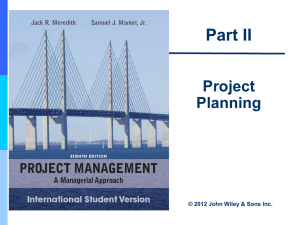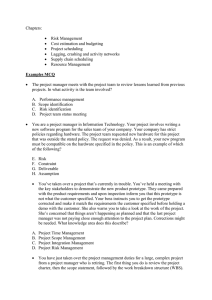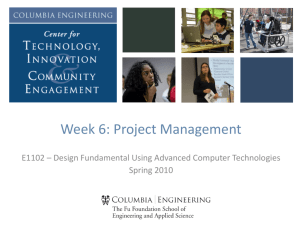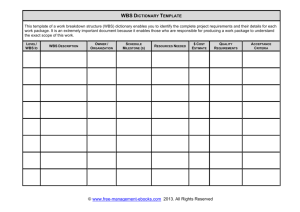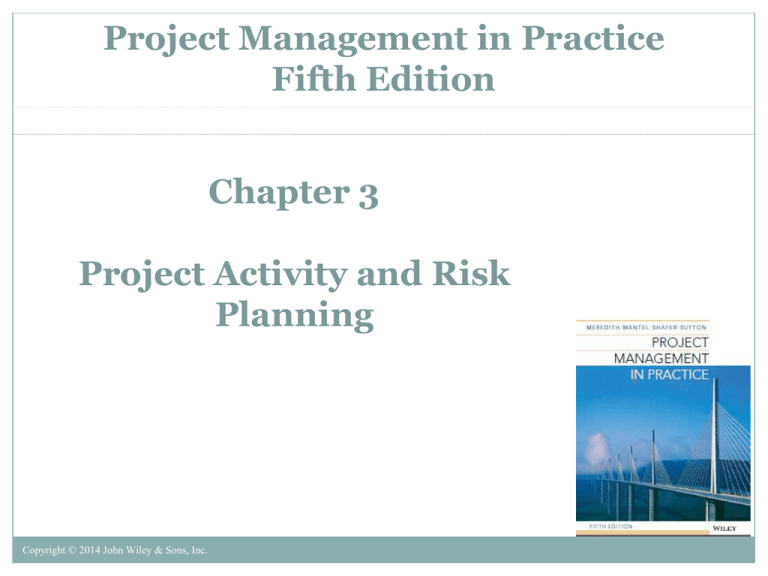
Project Management in Practice
Fifth Edition
Chapter 3
Project Activity and Risk
Planning
Copyright © 2014 John Wiley & Sons, Inc.
Two Extremes Approaches to
Planning
• “Ready, fire, aim”
– Tom Peters
• “Paralysis by analysis”
• There is a happy medium that everyone
would like to strike
3-2
The Basis of a Project Plan-the
“Project Charter”
• Primary function of a project plan is to
serve as a roadmap
• Should include the business case and
strategic reasons for the project
• Should contain sufficient information to
know the status of the project at any time
• Also needs the project’s history to date
3-3
Categories of Elements Required in
the Project Charter
1.
2.
3.
4.
5.
6.
7.
8.
Purpose
Objectives
Overview
Schedules
Resource requirements
Personnel and stakeholders
Risk management
Evaluation methods
Slide on each
3-4
Purpose
• Business case for the project
–
–
–
–
–
Strategic reasons for the project
Expected profitability
Competitive effects
Desired scope
Any other technical results
• Intent is to communicate to stakeholders the
reasons for the project
3-5
Objectives
• Another name is project mission statement
• More detailed description of the…
– Scope
– Deliverables
– Outcomes
• Communicate to project team members
what will be done to achieve the overall
project objectives
3-6
Overview
•
•
•
•
•
•
•
Intended for senior management
Brief description of project
Deliverables
Milestones
Expected profitability and competitive effects
Technological and managerial approaches
Agreements with the client or any third party
3-7
Schedule
• Summary of schedules and milestones
• Work breakdown structure (WBS)
• Time to complete each task
3-8
Resource Requirements
• Estimates of project expenses
– Capital and operating
•
•
•
•
Costs associated with each task
Overhead and fixed charges
Appropriate account numbers
Project budget
3-9
Personnel and Stakeholders
• Stakeholders, sponsor, project manager, and
some team members
• Special skill requirements
• Necessary training
• Special legal arrangements
– Such as non-disclosure agreements
3-10
Risk Management
• Listing of potential disasters
– Major and minor
– Late subcontractor deliveries, bad weather,
unreasonable deadlines, equipment failure,
changes in project scope
• Contingency plans are described
– Does not stop disasters
– Softens the impact
3-11
Evaluation Methods
• Evaluation procedures and quality standards
• Procedures for monitoring, collecting, and
storing data on project performance
3-12
The Planning Process-Overview
1. Develop and evaluate the concept of the project
2. Carefully identify what project deliverables must
have to be successful
3. Create a system
4. Test the prototype
5. Integrate the deliverable into target system
6. Validate the deliverable
7. Let client test it
8. Make sure client understands operating and
maintenance requirements
3-13
The Planning Process-Nuts and
Bolts
•
•
Once approved, project should have a launch
meeting
New project manager should review project
objectives
1. Make sure they understand
2. Identify important senior managers
3. Determine if anything is atypical
•
Senior manager introduces project to group
–
Project manager chairs launch meeting
3-14
Results of the Launch Meeting
1. The project’s scope is understood
2. Various functional managers understand
their responsibilities and have committed
to develop an initial task and resource plan
3. Any potential benefits to the organization
outside the scope are noted
3-15
Sorting Out the Project-The Work
Breakdown Structure (WBS)
• Inadequate up-front planning is a primary
contributor to the failure of a project
• A primary purpose of the WBS is to ensure
that no task is overlooked
• Every task, no matter how small, should be
listed
– Along with material and human resources
• This is a non-trivial task
3-16
A Sample (Partial) WBS
Figure 3-1
3-17
Notes on WBS
• Microsoft Project (MSP) will make a WBS list at the touch
of a key
– But not a tree-chart
• At any given level, the “generality” or “degree of detail” of
the tasks should be roughly at the same level
• The breakdown of level 1 tasks should be delegated to
someone who will carry out the level 2 tasks
• The job of planning should be delegated to the lowest
competent level
3-18
Extensions of the Everyday WBS
•
•
WBS generally oriented towards deliverables
Can be reshaped with some additional data often
not included in the WBS
1.
2.
3.
4.
•
Estimates of resources for each task
Estimates of the time for each task
Who has responsibility for each task
Sequence information for each task
Increases it orientation toward planning and
administration
3-19
A Modified WBS for Improving
Staff Orientation
Table 3-2 (Partial)
3-20
More on the Work Breakdown
Structure and Other Aids
• RACI Matrix is a table
• Project tasks derived from the WBS listed
in rows and departments and individuals in
the columns
• Helps organize the project team
3-21
The RACI Matrix
Figure 3-5
3-22
A Whole-Brain Approach to Project
Planning
• Mind mapping is a visual approach that closely
mirrors the way the human brain records and
stores information
• In addition to its visual nature, this methodology
has the advantage of tapping in to the creative
potential of multiple team members
• Mind mapping is an entertaining approach that
helps generate enthusiasm and involvement
3-23
Sample Mind Map
Figure 3-9
3-24
Risk Management
1. Risk identification
2. Risk analysis
3. Response to risk
3-25
Breakdown into Sub-processes
1.
2.
3.
4.
5.
6.
Risk management planning
Risk identification
Qualitative risk analysis
Quantitative risk analysis
Risk response planning
Risk monitoring and control
Slide on each
3-26
Risk Management Planning
• Like any other planning process
• Must ensure that the necessary resources
can be applied in a timely manner
• It is a continuous process
• The factors that cause uncertainty change
over time
3-27
Risk Identification and Qualitative
Risk Analysis
•
•
Steps 2-3 often carried out together
Scenario analysis
–
–
•
Well-known method for identifying risk
Involves envisioning likely scenarios and resulting outcomes
Failure mode and effect analysis (FMEA)
1.
2.
3.
4.
5.
6.
List ways project might fail
List consequences and evaluate its severity
List cause and likelihood
Estimate the ability to detect each failure
Calculate the risk priority number
Sort the potential failures by their risk priority number
3-28
Quantitative Risk Analysis
• State outcomes as probability distribution and use
distributions to evaluate the desirability of certain
decisions
• Objective is to illustrate the risk profile of the
outcomes
• Risk profiles are one factor to consider in making
the decision
• Techniques for analysis include:
– Expected value
– Simulation
3-29
Risk Response Planning
• Deciding on which risks to prepare for and which
to ignore
• Main preparation is a risk response plan
• Risk response plan includes contingency plans and
logic charts detailing what to do
– Contingency plan is a backup for some emergency or
unplanned event (“plan B”)
– Logic chart shows the flow of activities once a backup
plan is initiated
3-30
Risk Monitoring and Control
• Monitoring and control are tasks for the
parent organization
– As well as the project
• Must keep records for future projects
• Also must continue to search for new risks
3-31
Copyright
Copyright © 2014 John Wiley & Sons, Inc.
All rights reserved. Reproduction or translation of this work
beyond that permitted in Section 117 of the 1976 United
States Copyright Act without express permission of the
copyright owner is unlawful. Request for further information
should be addressed to the Permissions Department, John
Wiley & Sons, Inc. The purchaser may make back-up copies
for his/her own use only and not for distribution or resale.
The Publisher assumes no responsibility for errors, omissions,
or damages, caused by the use of these programs or from the
use of the information herein.
3-32



